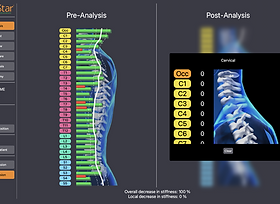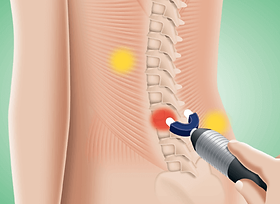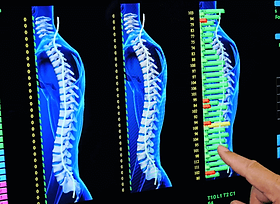Our Specialty: PulStar
Computerized Spinal Analysis and Chiropractic Treatment System
PulStar's Computerized Multiple Impulse Therapy (MIT)
Technology has advanced our ability to successfully and quickly treat the most common neuromusculoskeletal complaints, such as low back and neck pain. In keeping up with the latest scientific technology to best serve our patients, we offer the newest state-of-the-art chiropractic technology with the PulStar system.
PulStar system is an FDA-registered device developed to provide spinal analysis and identify problematic areas that need treatment. It helps the chiropractor deliver precise computer-controlled impulses in specific areas. PulStar involves analysis and treatment (adjustment) to reduce neuromusculoskeletal pain due to joint dysfunction (i.e., restricted joint range of motion, muscle spasm, ligamentous sprain).
PulStar Multiple Impulse Therapy (MIT) is safe and effective for all ages because it uses precise computer-controlled gentle impulses. No strong or heavy forces or twisting is required to produce the desired results of treatment.
How it works:
The PulStar uses a handheld impulse head containing sensors and is connected to a computer program. Each spinal joint is analyzed for proper function and then displayed as a graph providing precise information regarding joint functions. This data provides valuable clinical information to determine the most effective course of treatment to obtain the best results for the patient.
Spinal Analysis: The force sensor in the impulse head measures the resistance to the impulse (spinal stiffness) when pressed against the patient's spine.
Impulse Head Control System: The computer displays the results of the analysis. It is similar to displaying a computer-assisted spinal palpation in bar graphs.
Treatment: Delivers a series of precise, computer-controlled, gentle impulses to the areas selected by the chiropractor while measuring the musculoskeletal stiffness (i.e., spinal stiffness) at each impulse. The changes in musculoskeletal stiffness during treatment are displayed to the chiropractor and used to monitor the treatment. Impulse frequency varies automatically as the stiffness changes during therapy. The goal is to free up joint fixation, relieve muscle spasms, and restore normal joint function.
Post-Analysis: A post-analysis is performed and compared with the pre-treatment analysis to visualize and verify the treatment results. Comparing pre and post-analysis from each patient's visit provides valuable clinical information to track treatment and improvement.




1. Single gentle impulse to the vertebral level of interest during analysis.
2. Displays analysis in bar graphs, indicating muscle tightness, intersegmental stiffness, and dysfunction between the vertebrae.
3. Delivers multiple impulse therapy to reduce restriction and more motion to the segment while seeing the adjustment results on the screen in real-time.



4. Post-analysis is done by scanning the spine after the adjustment to visualize and verify the treatment results.
